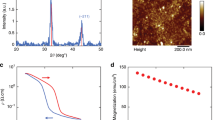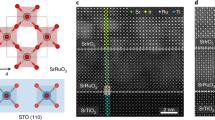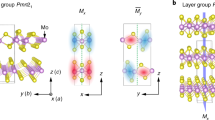Abstract
After 50 years of development, the technology of today’s electronics is approaching its physical limits, with feature sizes smaller than 10 nanometres. It is also becoming clear that the ever-increasing power consumption of information and communication systems1 needs to be contained. These two factors require the introduction of non-traditional materials and state variables. As recently highlighted2, the remanence associated with collective switching in ferroic systems is an appealing way to reduce power consumption. A promising approach is spintronics, which relies on ferromagnets to provide non-volatility and to generate and detect spin currents3. However, magnetization reversal by spin transfer torques4 is a power-consuming process. This is driving research on multiferroics to achieve low-power electric-field control of magnetization5, but practical materials are scarce and magnetoelectric switching remains difficult to control. Here we demonstrate an alternative strategy to achieve low-power spin detection, in a non-magnetic system. We harness the electric-field-induced ferroelectric-like state of strontium titanate (SrTiO3)6,7,8,9 to manipulate the spin–orbit properties10 of a two-dimensional electron gas11, and efficiently convert spin currents into positive or negative charge currents, depending on the polarization direction. This non-volatile effect opens the way to the electric-field control of spin currents and to ultralow-power spintronics, in which non-volatility would be provided by ferroelectricity rather than by ferromagnetism.
This is a preview of subscription content, access via your institution
Access options
Access Nature and 54 other Nature Portfolio journals
Get Nature+, our best-value online-access subscription
$29.99 / 30 days
cancel any time
Subscribe to this journal
Receive 51 print issues and online access
$199.00 per year
only $3.90 per issue
Buy this article
- Purchase on Springer Link
- Instant access to full article PDF
Prices may be subject to local taxes which are calculated during checkout




Similar content being viewed by others
Data availability
The data that support the findings of this study are available from the corresponding authors upon reasonable request.
References
Jones, N. How to stop data centres from gobbling up the world’s electricity. Nature 561, 163–166 (2018).
Manipatruni, S., Nikonov, D. E. & Young, I. A. Beyond CMOS computing with spin and polarization. Nat. Phys. 14, 338–343 (2018).
Žutić, I., Fabian, J. & Das Sarma, S. Spintronics: fundamentals and applications. Rev. Mod. Phys. 76, 323–410 (2004).
Slonczewski, J. C. Current-driven excitation of magnetic multilayers. J. Magn. Magn. Mater. 159, L1–L7 (1996).
Heron, J. T. et al. Deterministic switching of ferromagnetism at room temperature using an electric field. Nature 516, 370–373 (2014).
Gränicher, H. Induzierte Ferroelektricität von SrTiO3 bei sehr tiefen Temperaturen und über die Kälteerzeugung durch adiabatische Entpolarisierung. Helv. Phys. Acta 29, 210–212 (1956).
Hemberger, J., Lunkenheimer, P., Viana, R., Böhmer, R. & Loidl, A. Electric-field-dependent dielectric constant and nonlinear susceptibility in SrTiO3. Phys. Rev. B 52, 13159–13162 (1995).
Sidoruk, J. et al. Quantitative determination of domain distribution in SrTiO3 — competing effects of applied electric field and mechanical stress. J. Phys. Condens. Matter 22, 235903 (2010).
Manaka, H., Nozaki, H. & Miura, Y. Microscopic observation of ferroelectric domains in SrTiO3 using birefringence imaging techniques under high electric fields. J. Phys. Soc. Jpn 86, 114702 (2017).
Caviglia, A. D. et al. Tunable Rashba spin-orbit interaction at oxide interfaces. Phys. Rev. Lett. 104, 126803 (2010).
Ohtomo, A. & Hwang, H. Y. A high-mobility electron gas at the LaAlO3/SrTiO3 heterointerface. Nature 427, 423–426 (2004); correction 441, 120 (2006).
Soumyanarayanan, A., Reyren, N., Fert, A. & Panagopoulos, C. Emergent phenomena induced by spin–orbit coupling at surfaces and interfaces. Nature 539, 509–517 (2016).
Edelstein, V. M. Spin polarization of conduction electrons induced by electric current in two-dimensional asymmetric electron systems. Solid State Commun. 73, 233–235 (1990).
Kondou, K. et al. Fermi-level-dependent charge-to-spin current conversion by Dirac surface states of topological insulators. Nat. Phys. 12, 1027–1031 (2016).
Hoffmann, A. Spin Hall effects in metals. IEEE Trans. Magn. 49, 5172–5193 (2013).
Bychkov, Y. A. & Rashba, E. I. Properties of a 2D electron gas with lifted spectral degeneracy. JETP Lett. 39, 78–81 (1984).
Sánchez, J. C. R. et al. Spin-to-charge conversion using Rashba coupling at the interface between non-magnetic materials. Nat. Commun. 4, 2944 (2013).
Picozzi, S. Ferroelectric Rashba semiconductors as a novel class of multifunctional materials. Front. Phys. 2, https://doi.org/10.3389/fphy.2014.00010 (2014).
Rinaldi, C. et al. Ferroelectric control of the spin texture in GeTe. Nano Lett. 18, 2751–2758 (2018).
Kolobov, A. V. et al. Ferroelectric switching in epitaxial GeTe films. APL Mater. 2, 066101 (2014).
Rinaldi, C. et al. Evidence for spin to charge conversion in GeTe(111). APL Mater. 4, 032501 (2016).
Bibes, M., Vila, L., Attané, J.-P., Noël, P. & Vaz, D. C. Dispositif électronique, porte numérique, composant analogique et procédé de génération d’une tension. French patent FR18 74319 (2018).
Manipatruni, S. et al. Scalable energy-efficient magnetoelectric spin–orbit logic. Nature 565, 35–42 (2019).
Rödel, T. C. et al. Universal fabrication of 2D electron systems in functional oxides. Adv. Mater. 28, 1976–1980 (2016).
Vaz, D. C. et al. Mapping spin–charge conversion to the band structure in a topological oxide two-dimensional electron gas. Nat. Mater. 18, 1187–1193 (2019).
Lesne, E. et al. Highly efficient and tunable spin-to-charge conversion through Rashba coupling at oxide interfaces. Nat. Mater. 15, 1261–1266 (2016).
Tserkovnyak, Y., Brataas, A. & Bauer, G. E. W. Enhanced Gilbert damping in thin ferromagnetic films. Phys. Rev. Lett. 88, 117601 (2002).
Noel, P. et al. Highly efficient spin-to-charge current conversion in strained HgTe surface states protected by a HgCdTe layer. Phys. Rev. Lett. 120, 167201 (2018).
Caviglia, A. D. et al. Electric field control of the LaAlO3/SrTiO3 interface ground state. Nature 456, 624–627 (2008).
Biscaras, J. et al. Limit of the electrostatic doping in two-dimensional electron gases of LaXO3(X = Al, Ti)/SrTiO3. Sci. Rep. 4, 6788 (2015).
Crassous, A. et al. Nanoscale electrostatic manipulation of magnetic flux quanta in ferroelectric/superconductor BiFeO3 / YBa2Cu3O7−δ heterostructures. Phys. Rev. Lett. 107, 247002 (2011).
Yamada, H. et al. Ferroelectric control of a Mott insulator. Sci. Rep. 3, 2834 (2013).
Haeni, J. H. et al. Room-temperature ferroelectricity in strained SrTiO3. Nature 430, 758–761 (2004).
Brataas, A., Tserkovnyak, Y., Bauer, G. E. W. & Halperin, B. I. Spin battery operated by ferromagnetic resonance. Phys. Rev. B 66, 060404 (2002).
Costache, M. V., Sladkov, M., Watts, S. M., van der Wal, C. H. & van Wees, B. J. Electrical detection of spin pumping due to the precessing magnetization of a single ferromagnet. Phys. Rev. Lett. 97, 216603 (2006).
Ando, K. et al. Inverse spin-Hall effect induced by spin pumping in metallic system. J. Appl. Phys. 109, 103913 (2011).
Acknowledgements
The authors thank M. Cazayous, B. Dkhil, M. Maglione, S. Gambarelli and V. Maurel for useful discussions, as well as C. Carrétéro, E. Jacquet and Y. Gourdel for technical help. This work received support from the ERC Consolidator grant number 615759 “MINT”, the ERC Advanced grant number 833973 “FRESCO”, the QUANTERA project “QUANTOX”, the French Research Agency (ANR) as part of the “Investissement d’Avenir” programme (LABEX NanoSaclay, ref. ANR-10-LABX-0035) through project “AXION” and the Laboratoire d’Excellence LANEF (ANR-10-LABX-51-01) and ANR project OISO (ANR-17-CE24-0026-03). F.T. acknowledges support by research grant VKR023371 (SPINOX) from VILLUM FONDEN.
Author information
Authors and Affiliations
Contributions
J.-P.A., P.N., L.V. and M.B. designed the experiment. J.-P.A., L.V. and M.B. supervised the study. D.C.V., L.M.V.A. and J.B. prepared the samples. P.N. performed the spin–charge conversion experiments with J.-P.A. and L.V. J.B., S.F. and M.B. performed the polarization measurements with the help of V.G. and F.T. F.T. and J.B. performed the transport experiments and analysed them with M.B. and A.B. M.B. and J.-P.A. wrote the paper with inputs from all authors.
Corresponding authors
Ethics declarations
Competing interests
The authors declare no competing interests.
Additional information
Peer review information Nature thanks Dmitri E. Nikonov, Sashi Satpathy and the other, anonymous, reviewer(s) for their contribution to the peer review of this work.
Publisher’s note Springer Nature remains neutral with regard to jurisdictional claims in published maps and institutional affiliations.
Extended data figures and tables
Extended Data Fig. 1 Gate-voltage dependence of the inverse Edelstein length in three different samples of NiFe(20 nm)/Al(0.9 nm)//STO.
The error bars are due to the small extra damping measured in this system. The estimated effective spin mixing conductance \({G}_{{\rm{eff}}}^{\uparrow \downarrow }\) is ranging from 1.2 nm−2 to 3.2 nm−2 with a mean value of 2.2 nm−2, leading to an injected spin current \({J}_{{\rm{S}}}^{{\rm{3D}}}\) ranging from 100 to 240 MA m−2 mT−2, with a mean value of 160 MA m−2 mT−2.
Extended Data Fig. 2 Spin-pumping signals obtained at 7 K on sample 2, for three different cool-downs from room temperature.
After each cool-down, the signal was measured before any gate-voltage application.
Extended Data Fig. 3 Spin-pumping and resistance loops of a NiFe/Al/STO sample.
Black data points, two-probe resistance R of a NiFe/Al/STO sample, measured in the spin-pumping setup as a function of the back-gate voltage. Red data points, normalized charge current production (Ic) measured by spin pumping.
Extended Data Fig. 4 Dependence of the produced current on the time spent after application of a positive or negative gate voltage.
Black squares, +200 V; red circles, −200 V. The measurements were performed at 7 K on sample 1.
Rights and permissions
About this article
Cite this article
Noël, P., Trier, F., Vicente Arche, L.M. et al. Non-volatile electric control of spin–charge conversion in a SrTiO3 Rashba system. Nature 580, 483–486 (2020). https://doi.org/10.1038/s41586-020-2197-9
Received:
Accepted:
Published:
Issue Date:
DOI: https://doi.org/10.1038/s41586-020-2197-9
Comments
By submitting a comment you agree to abide by our Terms and Community Guidelines. If you find something abusive or that does not comply with our terms or guidelines please flag it as inappropriate.



